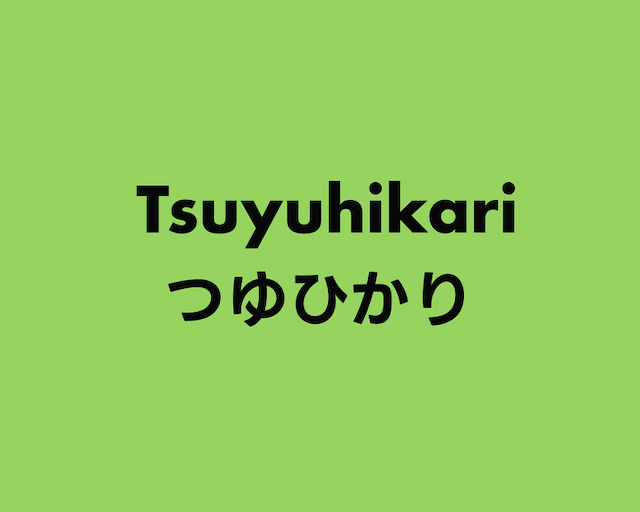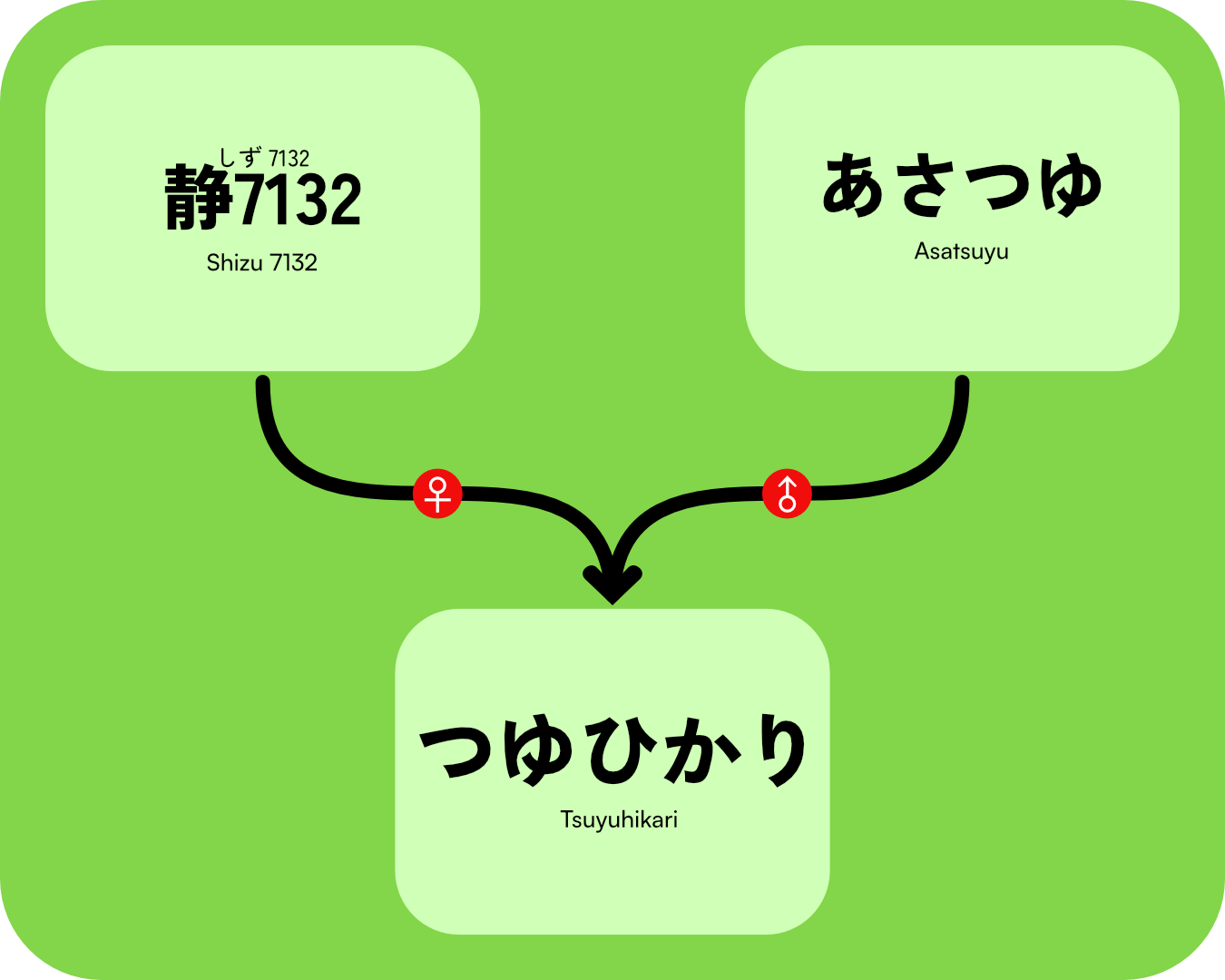Tsuyuhikari つゆひかり
Tsuyuhikari is a high-yielding, slightly early variety with high resistance to Anthracnose, fresh aroma and bright light colour.

Tsuyuhikari つゆひかり
Tsuyuhikari, a high-yielding, slightly early tea cultivar bred in 1970 at the Shizuoka Prefectural Tea Experiment Station, was officially registered in 2003. It’s known for its superior disease resistance, fresh aroma, and mild umami flavor with reduced astringency, making it a suitable replacement for Yabukita in sencha production throughout Japan.
Lineage
- Shizu 7132 ♀
- Asatsuyu ♂

History
Breed in 1970 at the Shizuoka Prefectural Tea Experiment Station[1] with Shizu-7132 as the mother and Asatsuyu as the father. This resulting strain, named 70-30-302 in particular, was selected individually again in 1979. Then again, in its Nutritional Comparison Test from 1982. Tests from 1991 to determine cultivar variety promotion, tested for productivity and characteristics, and regional adaptability until 1997. It was highly regarded even before registration.
It was named Tsuyuhikari in 2000, when it began the registration process, although it wouldn’t be officially registered until the 17th of March 2003 under the Seeds and Seedlings registry with registration number 11103. Its name inherits partially the meaning from one of its parents, Asatsuyu, regarded for its superior quality. Tsuyu means dew, and Hikari means light. Meaning it will bring a new light to the tea industry.
The cultivar was highly regarded even before registration as a tea cultivar. Although the registration process began in September 2000, after a selection process in a committee in February 2001, it became adopted as one of the main cultivars in the Shizuoka Prefecture tea cultivar promotion variety from April 2001. During that year, due to the selection as a tea cultivar promotion, its usage in the fields increased rapidly. Tsuyuhikari was selected and promoted as "a new face to replace Yabukita”. Together with two other cultivars, Koushun and Yamanoibuki. These three were promoted around the region to promote cultivar diversity.
According to the data from 2001, Yabukita represented 77% of the cultivated tea area in Japan and 91% of Shizuoka Prefecture. An interesting data point is that the decrease in Yabukita does not correspond to an increase in the other cultivars. Tsuyuhikari is the only cultivar whose cultivation area has increased considerably. Most others have remained approximately the same, only Okumidori and, notably, Zairai have increased their ha from 86 to 105 and from 156 to 185, respectively. This happened in a context where the total cultivated area has been considerably reduced in the past years from 20.800 ha in 2001 to 17.801 ha in 2015 and 13,800 ha in 2022, approximately 25% loss in 20 years.
Omaezaki, Tsuyuhikari City
In 2001, the local tea promotion council, concerned with the current trends, started exploring several ways to promote tea in the region. After an initial round of promotional activities, they started exploring other ways to boost sales. The homogeneity of the Yabukita cultivar and standardized production methods in Shizuoka didn't favor the municipality, and using new tea cultivars was considered a possible solution. In December 2001, further exploring the idea was decided.
In January 2002, the chief researcher at the Shizuoka Prefectural Tea Research Institute was invited as a lecturer to study the qualities of different cultivars for the region. The following cultivars were explored: Meiryoku, Saemidori, Okumidori, Okuhikari, Yamanoibuki, Koushun, Fushun, Asatsuyu, and Tsuyuhikari, at that time still an unregistered cultivar and still used a provisional name. Tsuyuhikari just started being promoted as a cultivar in the Shizuoka prefecture in April 2001. Tsuyuhikari flavour characteristics, especially the lack of a characteristic astringency present in Yabukita, were one of the reasons Tsuyuhikari was selected.
Breeder's rights under the Seeds and Seedlings Act will remain in force until 2028. Until then, seedlings can be exclusively from nurseries with licensing agreements with the Shizuoka Prefectural Tea Research Centre. After that date, seedlings are available from nationwide nurseries. Although Tsuyuhikari is used in many production farms around the country, recently, the low availability and the Prefecture becoming more protective, with seedlings only being sold inside the Prefecture, make it a rare cultivar outside the Shizuoka Prefecture. Cultivation outside Shizuoka was restricted in 2021.
Characteristics
In the nursery, the seedlings grown on the floor had a lower survival rate of 56% compared to the 76% of Yabukita. Other measurements, like the number of shoots and leaves during the first year and height, growth, and uniformity in the second, were also inferior to Yabukita. Studies to improve survival rates and avoid the defoliation of the plants reported positive results by utilizing windbreaks and tunnel covers. The growth and survival rate increased after the third year.
As for the growth in paper pods, data from 2002 measured growth at 3 and 5 months. The overall growth of Tsuyuhikari was inferior, except for a slightly higher number of leaves. The survival rate at this stage is quite similar for Tsuyuhikari and Yabukita in the study, at 96% and 99%, respectively. Rooting of cuttings is slightly poor but has good growth of seedlings after roots have firmly established.
The height of the tree was about the same as Yabukita. The tree trunk was broader than Yabukita, with a taller stump height, around 20 cm higher, at seven years old at the test location. The growth during the initial 3-year period is vigorous, and on the 3rd year mark, the autumn harvest is already almost double that of Yabukita. Budding time is one day earlier than Yabukita, and harvesting is up to two days earlier, thus placing Tsuyuhikari in the slightly early cultivar category.
New leaves are bright light green with a leaf shape between oblong and elliptic. Adult leaves are green and have a slightly less wavy surface. With a tad larger number of buds and a higher hundred-bud weight than Yabukita, it is considered a bud-heavy type of tea cultivar.
In Shizuoka, two independent research institutions regarding tea operate close to each other. The Shizuoka Prefectural Tea Research Centre. And the National Tea Research Centre under NARO. In this case, I will refer to the Shizuoka Prefectural Tea Research Centre unless otherwise stated.
The Shizuoka Prefectural Tea Research Centre has its main fields and installations on the grounds of its research centre in Makinohara, where construction of an open innovation tea research centre is ongoing and will open in 2025. There are two more facilities, a field in Fuji City and an Agricultural and Forestry Centre in Kawane town. Both in mountainous areas, where the trials for mountain growing conditions are carried out, also known as regional adaptability trial sites. The research on Tsuyuhikari in the Kawane research site revealed similar results to the ones in the Makinohara plateau. Vigorous growth overall, with the rate of growth for new leaves also higher compared to Yabukita. While the budding and picking period were the same as Yabukita in the Fuji field, it was two days earlier in the Kawane centre. The tests took place between 1991 and 1993.
Cold resistance and Red Blight incidence are about the same as Yabukita in the same area and could be grown anywhere in the country. As for Anthracnose, the damage was significantly lower than for Yabukita and the two other cultivars used during the trials at the research centre fields. Kurasawa being similar to Yabukita, both weak to anthracnose, and Sayamakaori, known to be very susceptible to anthracnose. Tsuyuhikari is mostly being unaffected. It is slightly resistant to the glutinous disease, like Yabukita, and more resistant than Kurasawa.
Yield for Tsuyuhikari is generally higher than Yabukita by around 130% when counting the first and second harvests. Yield is higher in the autumn harvest. The number of buds and their weight are roughly the same when averaging four years, corresponding to an age of 4 to 7 years old bush. The average buds are slightly shorter but heavier, with almost identical bud count. The mountain test sites experienced a similar trend, nearly doubling the production amount in the second harvest.
As aracha, the quality average score was similar to Yabukita, with the shape and aroma being rated higher than Yabukita for first harvest tea. Once rolled, the shape of the leaf is good, with a bit of a powdery appearance and a bright-green colour. Thus, the brew has a bit of sediment and turbidity with a bright-green colour. It also presents a nice green colour when deep steamed. Due to the fresh leaf characteristics, it is challenging to shape during production, and powder tends to occur. It requires extra care with the production conditions.
The aroma is fresh, and the flavour has mild umami harmonizing with a good textured body. In particular, its aroma and brew colour are praised and offer a distinctive but different experience. As for the results of the mountain test sites, aracha evaluation shows similar results. With aroma, in particular, for the first harvest in the Kawane site being the highest.
Chemical composition revealed more amino acids and L-theanine with less tannin concentration than Yabukita and other compared cultivars in the first harvest. Caffeine was also slightly lower than the rest of the cultivars. As for the second harvest, most values were the same if compared to Yabukita, but with a lower tannin content.
In summary, Tsuyuhikari has excellent disease and cold resistance, making it suitable for tea-growing areas throughout the country. Both in flatlands and mountain areas, including those areas with volcanic soils. It has high resistance to red blight and high resistance to anthracnose.It has vigorous growth and slightly early shooting growth. The leaves are prone to powdering during the processing of the tea leaves and need more careful management during processing. Tsuyuhikari is a cultivar recommended for Sencha production. Used as a cultivar for deep-steamed teas and for tencha and kamairicha production.
Furthermore, its use for fully oxidized and partially oxidized teas is also possible. The aromatic profile of Tsuyuhikari combined with the kaori-ryokucha[2] (similar to withered sencha) processing techniques developed by the Shizuoka Prefectural Tea Research Centre have a great synergy and are actively explored in aromatic-focused tea production. The Association for the Promotion of Fragrant Tea[3], formed by the Katsumata Kaitaku Cooperative[4], produces tea using the research on aromatic teas by the prefectural research station, just a few minutes walk from the cooperative factory.
References
Oyaizu, Tsutomu, et al. “A New Cultivar ‘tsuyuhikari’ for Green Tea.” Chagyo Kenkyu Hokoku (Tea Research Journal), vol. 2003, no. 95, June 2003, pp. 1–15, https://doi.org/10.5979/cha.2003.1.
A shorter translated version of the Tsuyuhikari cultivar paper above. https://www.ocha-festival.jp/archive/english/conference/ICOS2001/files/PROC/II-144.pdf
Tea Promotion Division, Agricultural Bureau, Department of Economy and Industry, Shizuoka Prefecture. 静岡県茶業の現状 Current State of the Shizuoka Tea Industry . Mar. 2023. https://www.pref.shizuoka.jp/res/projects/defaultproject/page/001/027/288/cyagyonogenjyo.pdf.
Team, Green Tea Merchant. “What Is Tsuyuhikari (御前崎茶-つゆひかり) Cultivar?” Green Tea Merchant Blog, 14 June 2022, https://www.shizuokatea.com/blog/what-is-tsuyuhikari-御前崎茶-つゆひかり-cultivar/.
World Green Tea Association. “Tsuyuhikari.” O-Chanet, https://www.o-cha.net/english/teacha/cultivar/tsuyuhikari.html. Accessed 30 Aug. 2023.
http://www.hinshu2.maff.go.jp/vips/cmm/apCMM112.aspx?TOUROKUNO=11103&LANGUAGE=Japanese
Tsuyuhikari MAFF Cultivar Registration Database page.
井上製茶園 Inoue Seichaen website. https://inoue-seichaen.com.
静岡県農林技術研究所 茶業研究センター Shizuoka Prefectural Agricultural and Forestry Research Institute, Tea Research Centre. Improved Rooting Characteristics and Early Growth of Tsuyuhikari.
https://www.pref.shizuoka.jp/res/projects/defaultproject/page/001/044/307/033.pdf.
Report showcasing several projects related to tea by the Regional Crops Division, Department of Agriculture, Bureau of Production. Published 26 February 2015. https://www.maff.go.jp/j/seisan/tokusan/cha/pdf/cha2.pdf
Last update: 2025 July 10th
